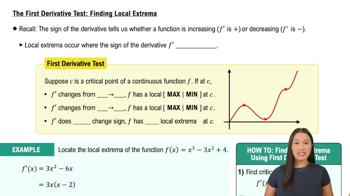Table of contents
- 0. Functions7h 52m
- Introduction to Functions16m
- Piecewise Functions10m
- Properties of Functions9m
- Common Functions1h 8m
- Transformations5m
- Combining Functions27m
- Exponent rules32m
- Exponential Functions28m
- Logarithmic Functions24m
- Properties of Logarithms34m
- Exponential & Logarithmic Equations35m
- Introduction to Trigonometric Functions38m
- Graphs of Trigonometric Functions44m
- Trigonometric Identities47m
- Inverse Trigonometric Functions48m
- 1. Limits and Continuity2h 2m
- 2. Intro to Derivatives1h 33m
- 3. Techniques of Differentiation3h 18m
- 4. Applications of Derivatives2h 38m
- 5. Graphical Applications of Derivatives6h 2m
- 6. Derivatives of Inverse, Exponential, & Logarithmic Functions2h 37m
- 7. Antiderivatives & Indefinite Integrals1h 26m
- 8. Definite Integrals4h 44m
- 9. Graphical Applications of Integrals2h 27m
- 10. Physics Applications of Integrals 2h 22m
5. Graphical Applications of Derivatives
The Second Derivative Test
Problem 47
Textbook Question
Each of Exercises 43–48 gives the first derivative of a function y = ƒ(𝓍). (a) At what points, if any, does the graph of ƒ have a local maximum, local minimum, or inflection point? (b) Sketch the general shape of the graph.
y' = 𝓍⁴ ― 2𝓍²
 Verified step by step guidance
Verified step by step guidance1
First, identify the critical points by setting the first derivative y' = 𝓍⁴ - 2𝓍² equal to zero and solving for 𝓍. This will help us find potential points for local maxima, minima, or inflection points.
Factor the equation 𝓍⁴ - 2𝓍² = 0 to simplify the process of finding critical points. Notice that it can be factored as 𝓍²(𝓍² - 2) = 0.
Solve the factored equation 𝓍²(𝓍² - 2) = 0. This gives us 𝓍² = 0 or 𝓍² = 2. From 𝓍² = 0, we get 𝓍 = 0. From 𝓍² = 2, we get 𝓍 = ±√2.
To determine the nature of each critical point (local maximum, minimum, or inflection point), use the second derivative test. Compute the second derivative y'' by differentiating y' = 𝓍⁴ - 2𝓍² again.
Evaluate the second derivative at each critical point (𝓍 = 0, 𝓍 = ±√2) to determine concavity. If y'' > 0, the point is a local minimum; if y'' < 0, it's a local maximum; if y'' = 0, further analysis is needed to determine if it's an inflection point.
 Verified video answer for a similar problem:
Verified video answer for a similar problem:This video solution was recommended by our tutors as helpful for the problem above
Video duration:
9mPlay a video:
Was this helpful?
Key Concepts
Here are the essential concepts you must grasp in order to answer the question correctly.
First Derivative Test
The First Derivative Test is a method used to determine local extrema of a function. By analyzing the sign of the first derivative, we can identify where the function is increasing or decreasing. A local maximum occurs where the derivative changes from positive to negative, while a local minimum occurs where it changes from negative to positive. Critical points, where the derivative is zero or undefined, are essential for applying this test.
Recommended video:

The First Derivative Test: Finding Local Extrema
Inflection Points
Inflection points are points on the graph of a function where the concavity changes. This means that the second derivative of the function changes sign at these points. To find inflection points, we first need to compute the second derivative and identify where it equals zero or is undefined. Understanding inflection points helps in sketching the graph and analyzing the behavior of the function.
Recommended video:

Critical Points
Graph Sketching
Graph sketching involves creating a rough representation of a function based on its critical points, local extrema, and inflection points. By using information from the first and second derivatives, we can determine the overall shape of the graph, including where it rises, falls, and changes concavity. This visual representation aids in understanding the function's behavior and is crucial for interpreting the results of derivative analysis.
Recommended video:

Summary of Curve Sketching

 6:02m
6:02mWatch next
Master The Second Derivative Test: Finding Local Extrema with a bite sized video explanation from Callie
Start learningRelated Videos
Related Practice



